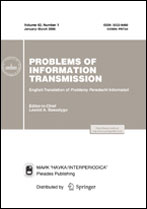|
|
Problemy Peredachi Informatsii, 2016, Volume 52, Issue 2, Pages 46–60
(Mi ppi2203)
|
 |
|
 |
Coding Theory
Almost cover-free codes
N. A. Polyanskyab
a Kharkevich Institute for Information Transmission Problems,
Russian Academy of Sciences, Moscow, Russia
b Probability Theory Department, Faculty of Mathematics and Mechanics, Lomonosov Moscow State University, Moscow, Russia
Abstract:
We say that an $s$-subset of codewords of a code $X$ is ($(s,\ell)$-bad if $X$ contains $\ell$ other codewords such that the conjunction of these $\ell$ words is covered by the disjunction of the words of the $s$-subset. Otherwise, an $s$-subset of codewords of $X$ is said to be $(s,\ell)$-bad. A binary code $X$ is called a disjunctive $(s,\ell)$ cover-free (CF) code if $X$ does not contain $(s,\ell)$-bad subsets. We consider a probabilistic generalization of $(s,\ell)$ CF codes: we say that a binary code is an $(s,\ell)$ almost cover-free (ACF) code if almost all $s$-subsets of its codewords are $(s,\ell)$-good. The most interesting result is the proof of a lower and an upper bound for the capacity of $(s,\ell)$ ACF codes; the ratio of these bounds tends as $s\to\infty$ to the limit value $\log_2e/(\ell e)$.
Received: 11.06.2015
Revised: 23.11.2015
Citation:
N. A. Polyansky, “Almost cover-free codes”, Probl. Peredachi Inf., 52:2 (2016), 46–60; Problems Inform. Transmission, 52:2 (2016), 142–155
Linking options:
https://www.mathnet.ru/eng/ppi2203 https://www.mathnet.ru/eng/ppi/v52/i2/p46
|


| Statistics & downloads: |
| Abstract page: | 224 | | Full-text PDF : | 49 | | References: | 43 | | First page: | 9 |
|





 Contact us:
Contact us: Terms of Use
Terms of Use
 Registration to the website
Registration to the website Logotypes
Logotypes








 Citation in format
Citation in format 